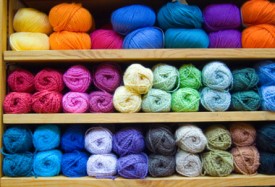By NANCY TARTAGLIONE
Deadline London
Knit one, purl … eight-plus hours of live stitching? That’s what’s happening Nov 1 night on Norwegian public broadcaster NRK2 as folks around the country gather in viewing parties. The show is part of a phenomenon known as Slow TV which has increasingly captivated Norway. The overall gist of the concept, to which LMNO Productions recently acquired U.S. rights, is a hybrid of unhurried documentary coupled with hours and hours of continuous coverage provided by fixed cameras trained on a subject or an event.
 Prior to tonight, those have included a 7.5-hour train journey, a 134-hour coastal cruise, a stack of firewood and salmon. On Nov 1, NRK2 will turn its lens on National Knitting Evening. Four hours of discussion on the popular pastime will kick off at 8 PM local, before a sheep gets trotted out at midnight to be sheared and its wool spun into yarn. Making Knitting Evening sound like a breathless frenzy of activity compared to some earlier Slow TV ventures, seven spinners and knitters will then hunker down to stitch a large men’s sweater in an attempt to break a Guinness world record — for speed, no less. NRK programming executive Rune Moklebust tells me the four-hour and 51-minute record will be “hard to break, but we’ll broadcast until the (sweater) is finished.” Moklebust is confident folks will stick with it through the wee hours, “like they’re waiting for election results.”
Prior to tonight, those have included a 7.5-hour train journey, a 134-hour coastal cruise, a stack of firewood and salmon. On Nov 1, NRK2 will turn its lens on National Knitting Evening. Four hours of discussion on the popular pastime will kick off at 8 PM local, before a sheep gets trotted out at midnight to be sheared and its wool spun into yarn. Making Knitting Evening sound like a breathless frenzy of activity compared to some earlier Slow TV ventures, seven spinners and knitters will then hunker down to stitch a large men’s sweater in an attempt to break a Guinness world record — for speed, no less. NRK programming executive Rune Moklebust tells me the four-hour and 51-minute record will be “hard to break, but we’ll broadcast until the (sweater) is finished.” Moklebust is confident folks will stick with it through the wee hours, “like they’re waiting for election results.”
Based on recent success, the exec has reason to be bullish. Slow TV started in 2009 when NRK was working on documentaries to celebrate the 100th birthday of the national train line and “an idea came up at lunch one day.” The result was Bergensbanen, a 7.5-hour continuous program that showed every minute of a train journey from Bergen to Oslo. (Think that sounds long? Even the trailer runs 9.5 minutes — see it here). The program aired on a Friday, the most-watched TV night in the country, and drew more than 1.2M viewers out of a population of 5M people. Ratings showed viewers weren’t only tuning in for two minutes, but were actually engrossed. The next Slow TV program came in 2011 with Hurtigruten: Minutt For Minutt, a 134-hour long show that followed a cruise ship down the coast. More than 3M viewers saw that one. “It was a national event, even the queen showed up,” Moklebust says. Other Slow shows have spent 18 hours covering the opening night of salmon fishing season and 12 hours on firewood. “It was three or four hours before the first salmon came ashore,” Mocklebust says, but at least one exec commented afterwards, “It felt a little short, don’t you think?” For the firewood show, experts spent four hours discussing chopping and stacking techniques (bark up or bark down?) and then built a fire and left it to burn. Mocklebust cautions it’s not to be confused with the Yule Log that Americans are used to. “We had no loop and no recording.” But after the fire went out, viewers wrote in and said, “Men have gotten their firewood night. Now women have to have their knitting night.” And Mocklebust said the reaction was, “Why on Earth haven’t we thought about it before?”
Source: Deadline London
